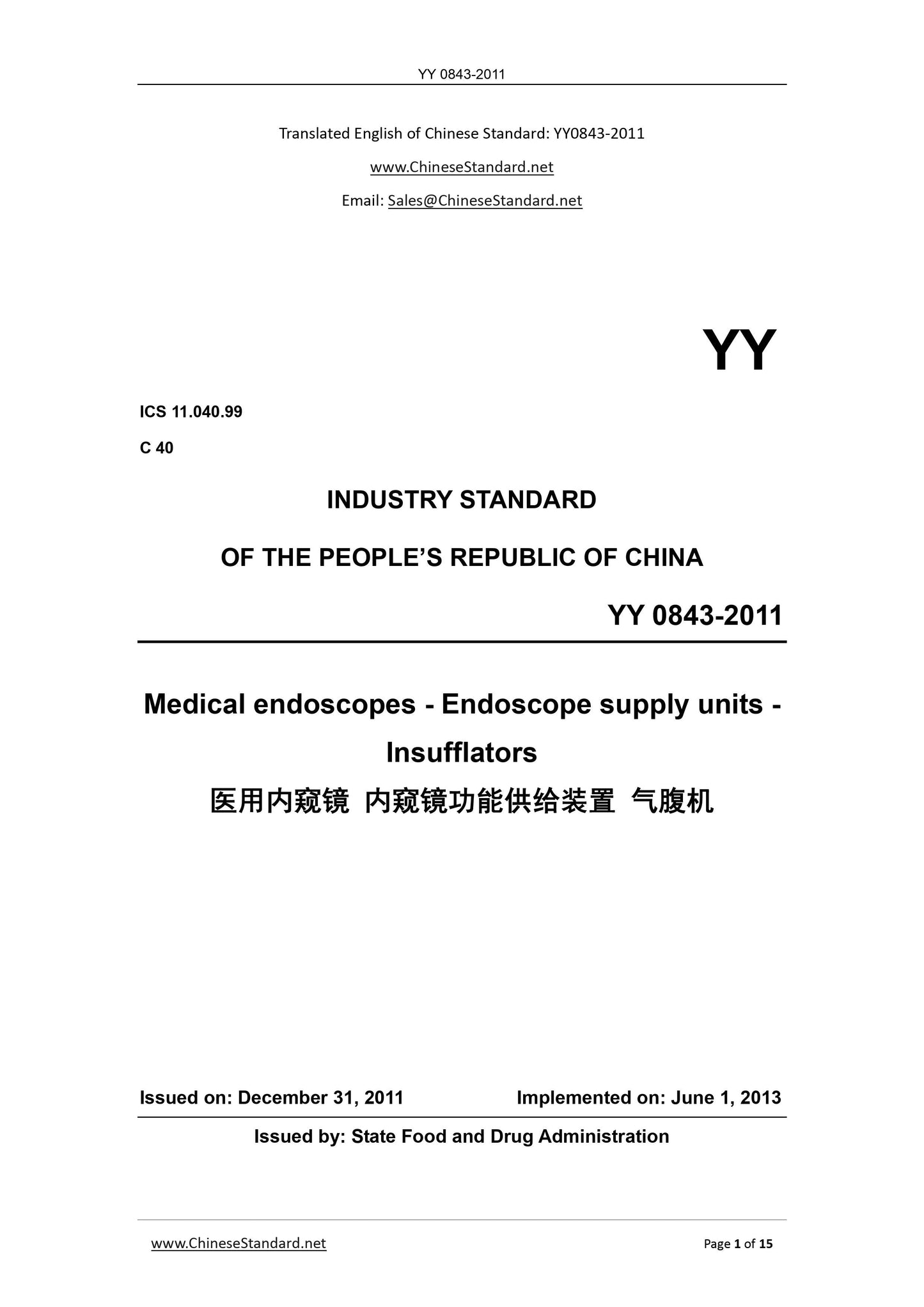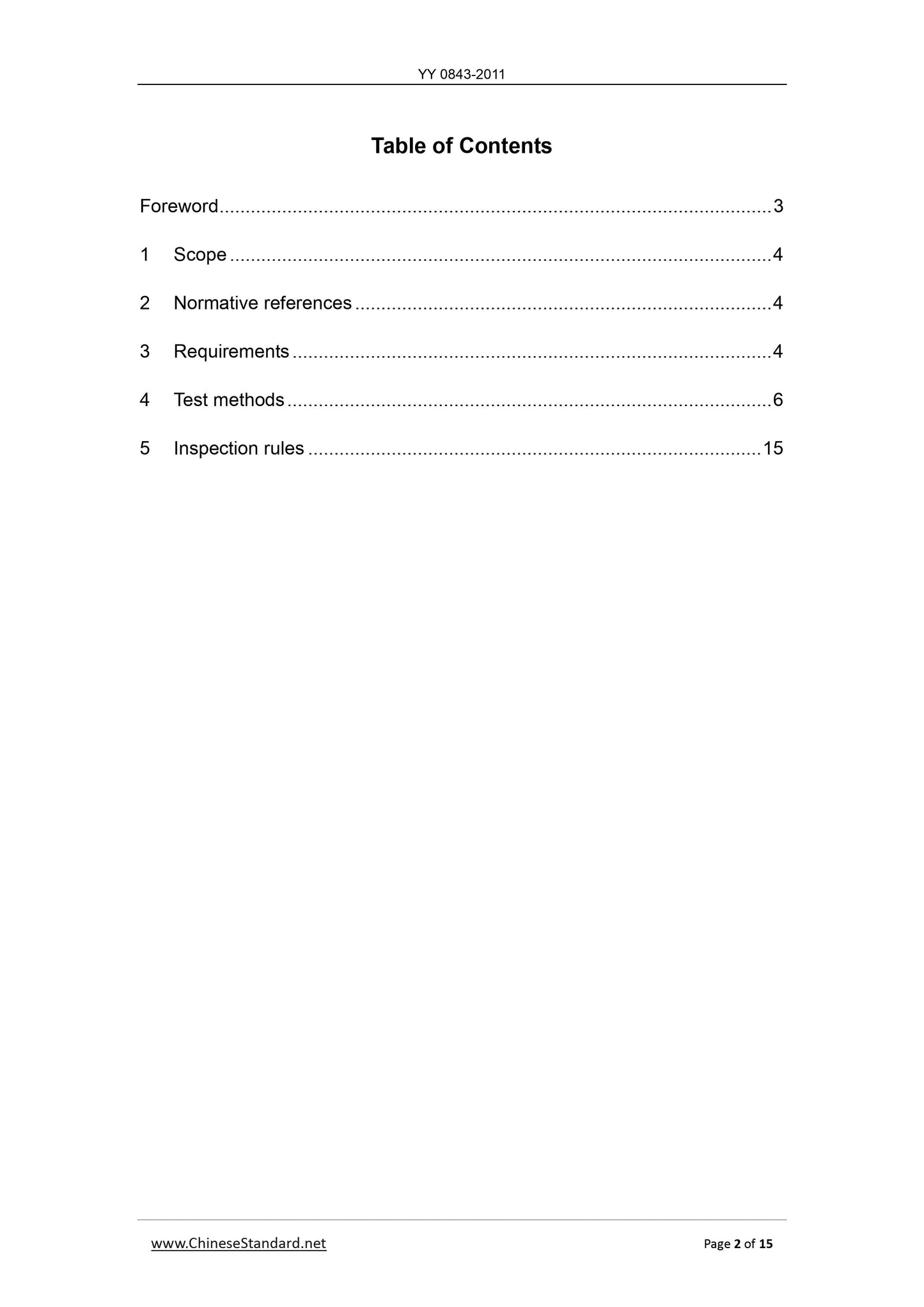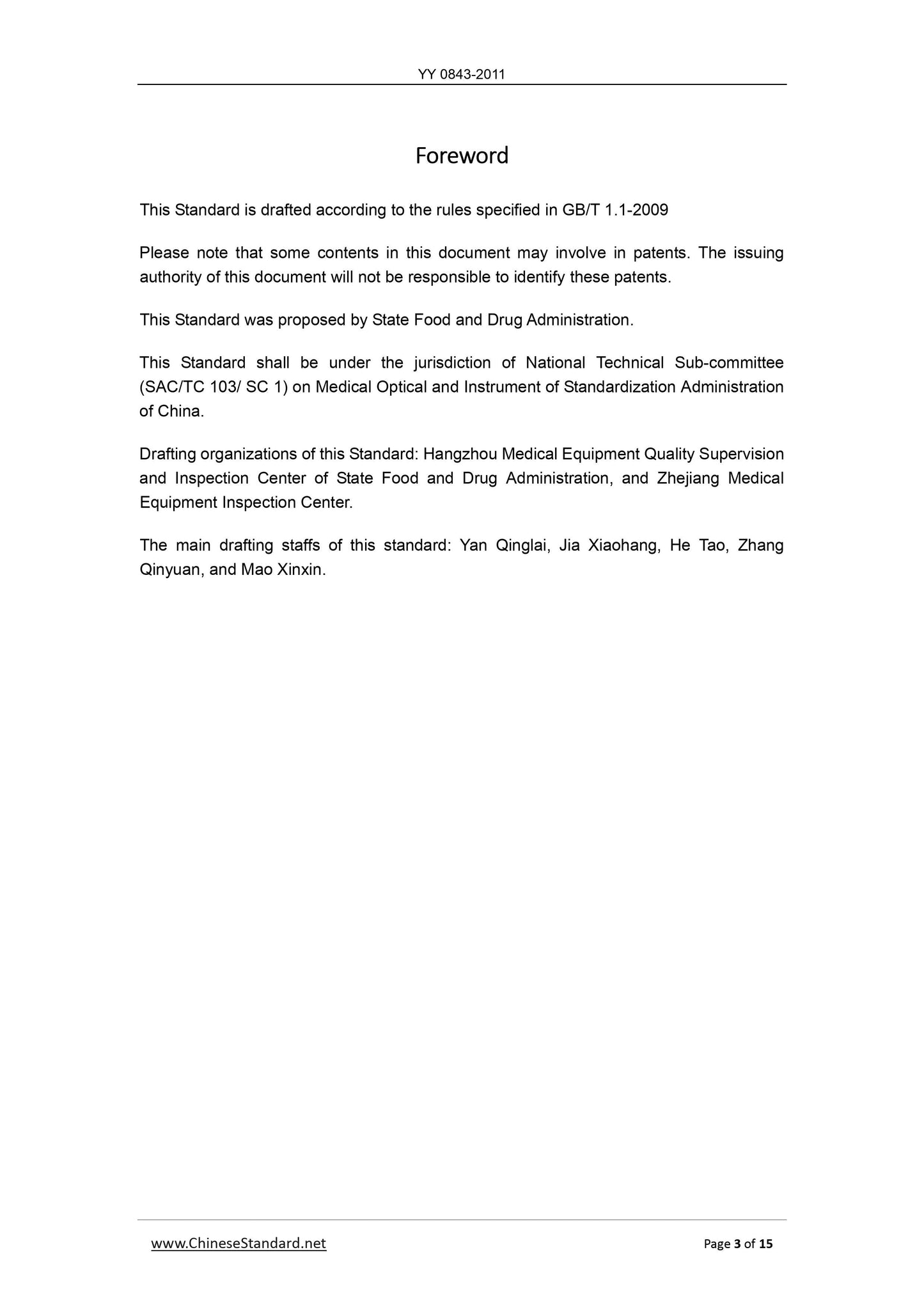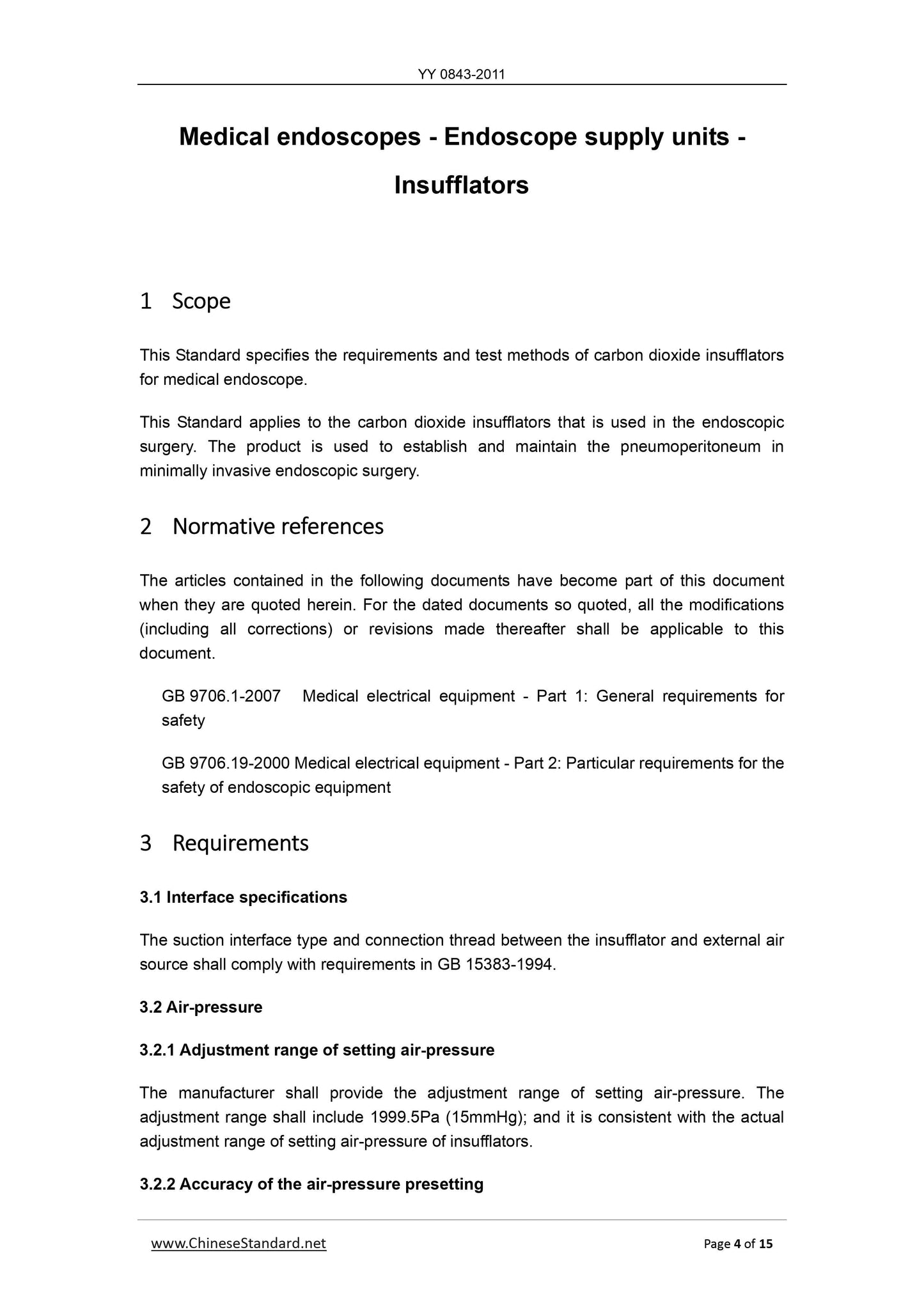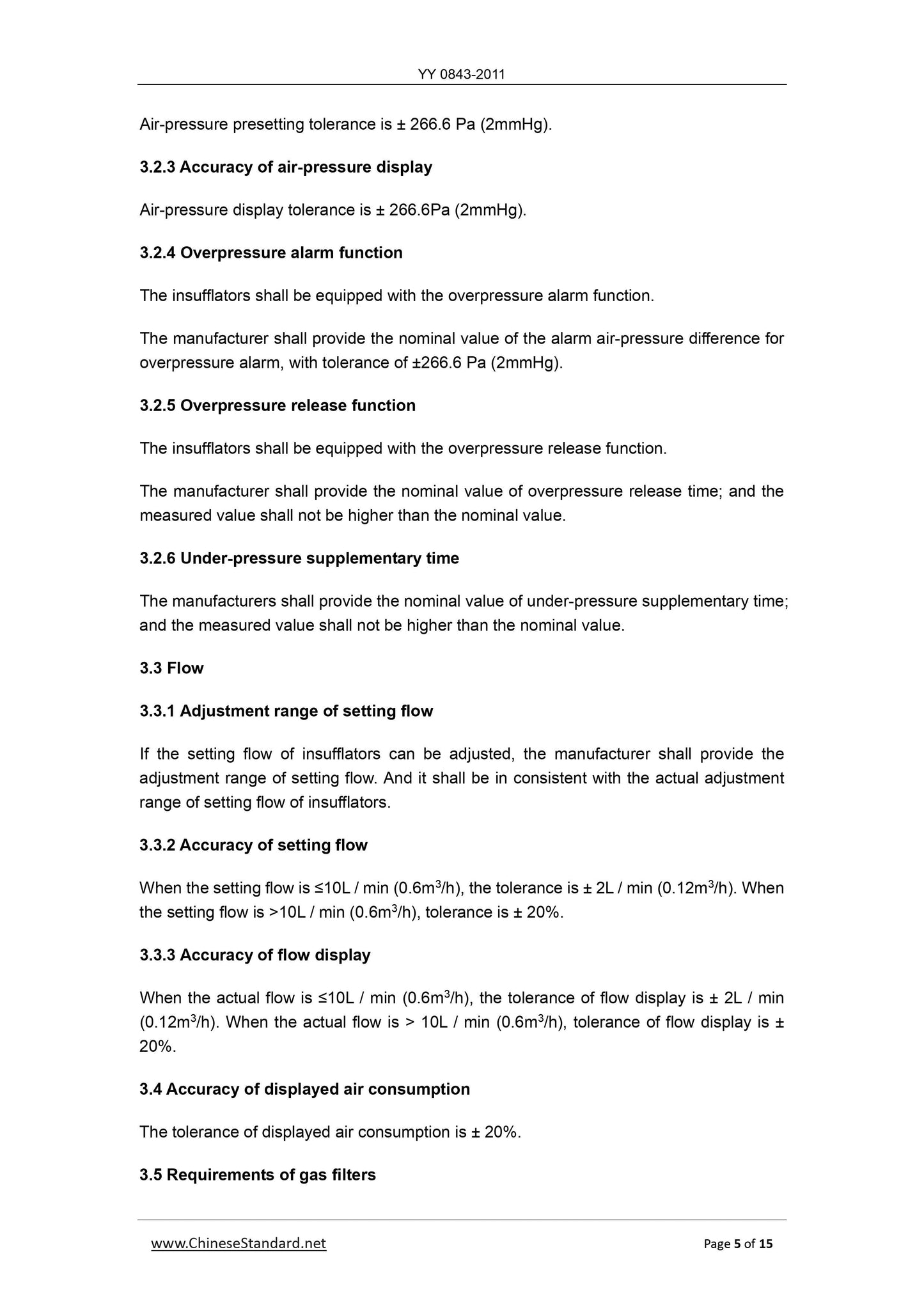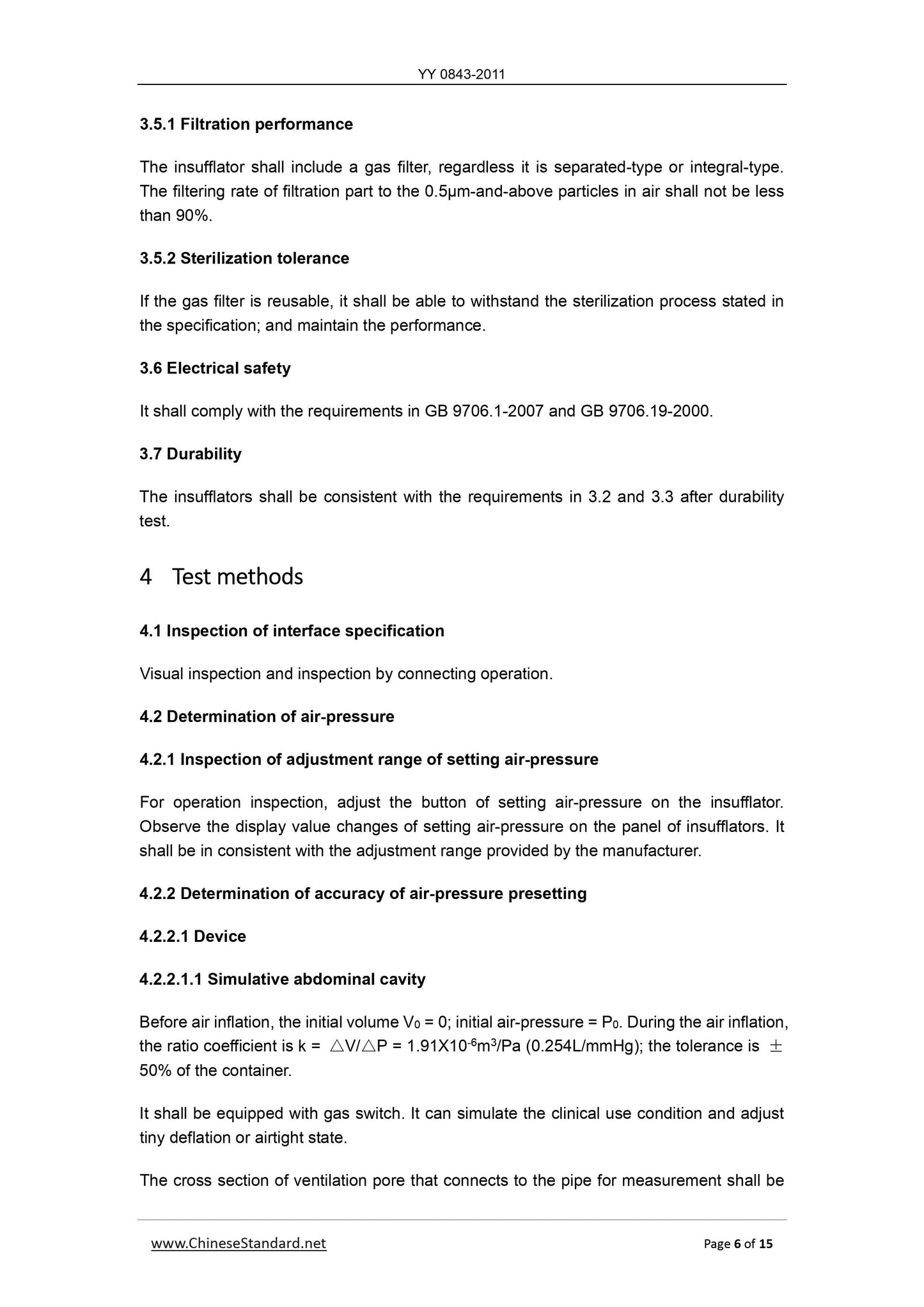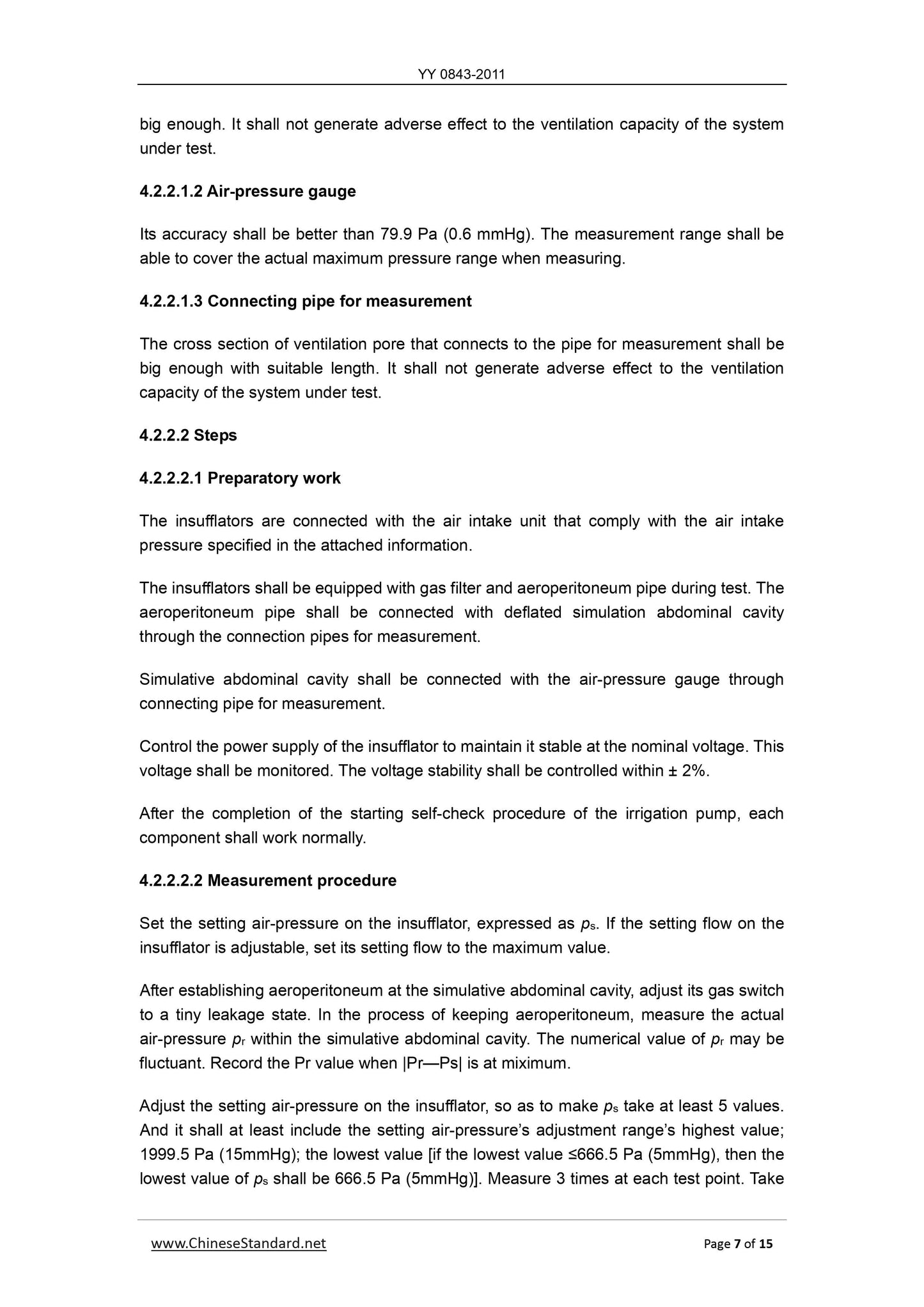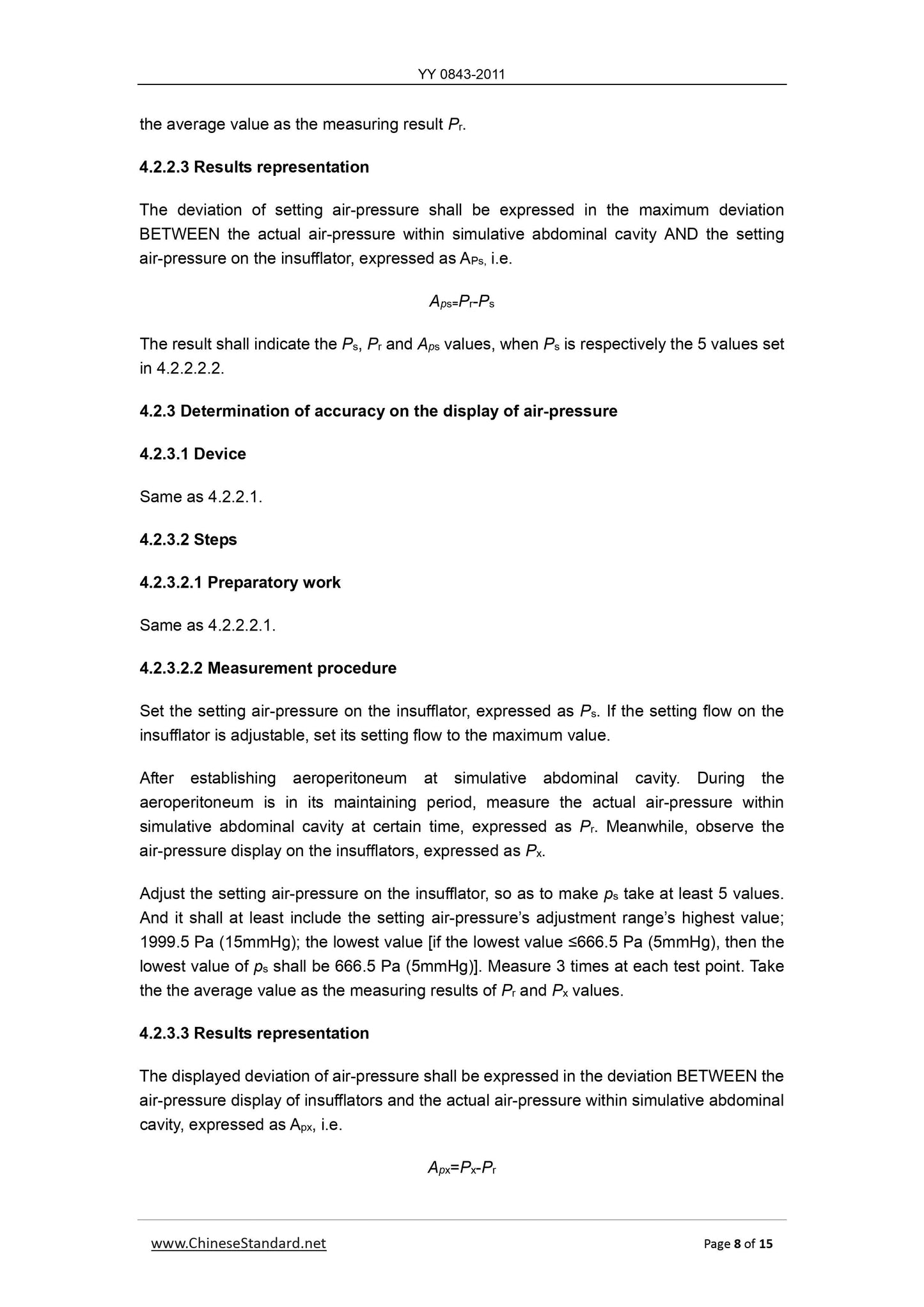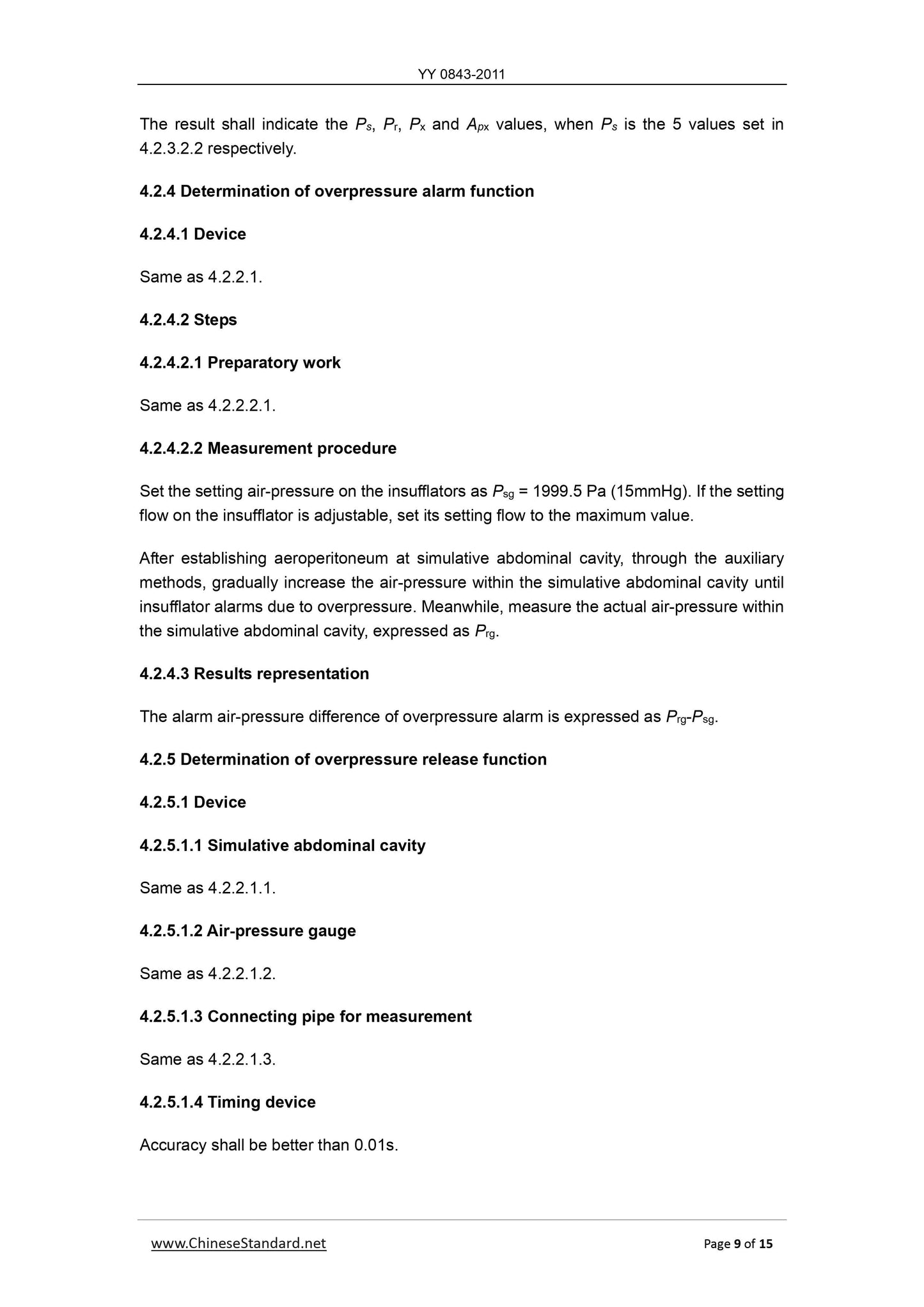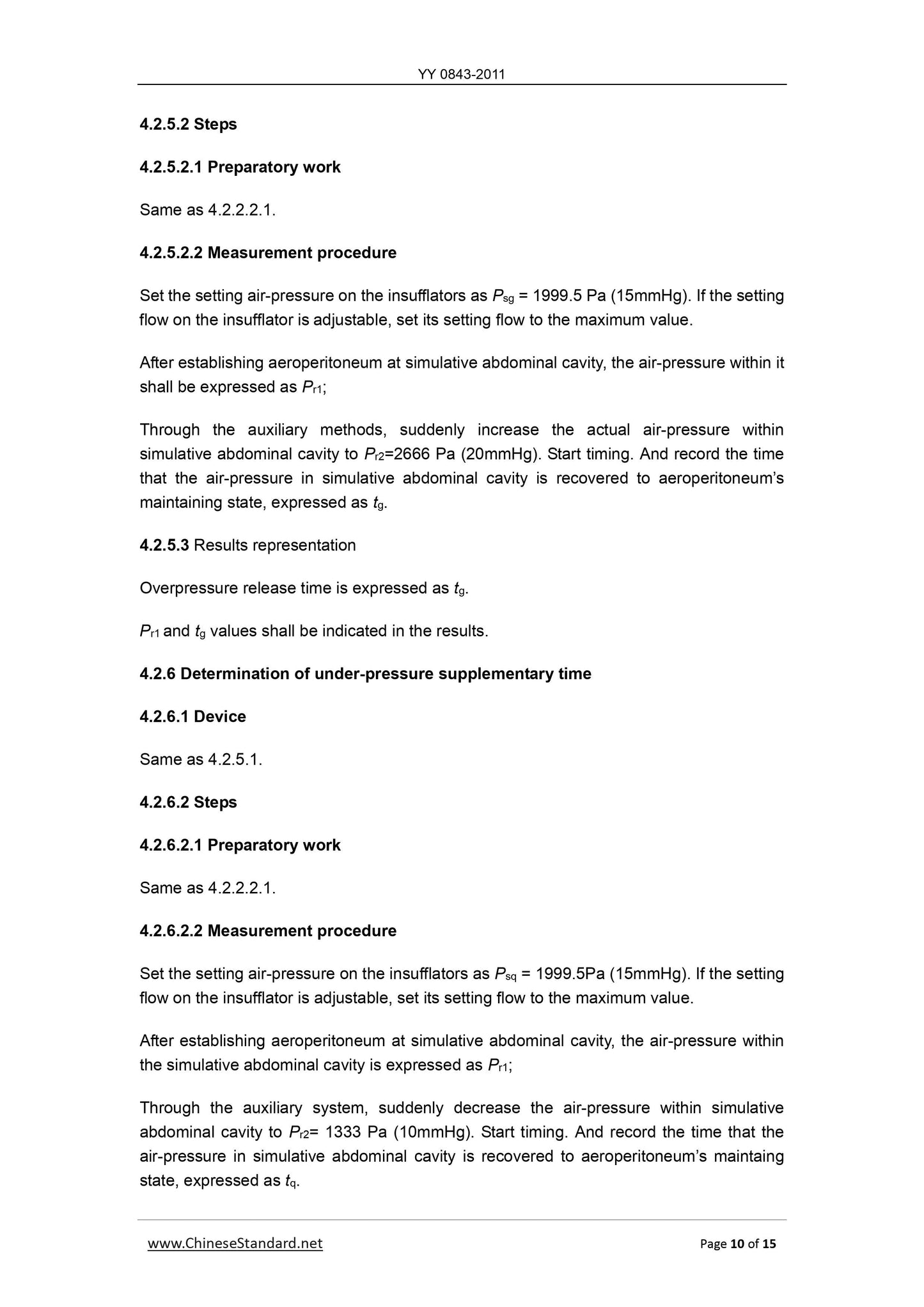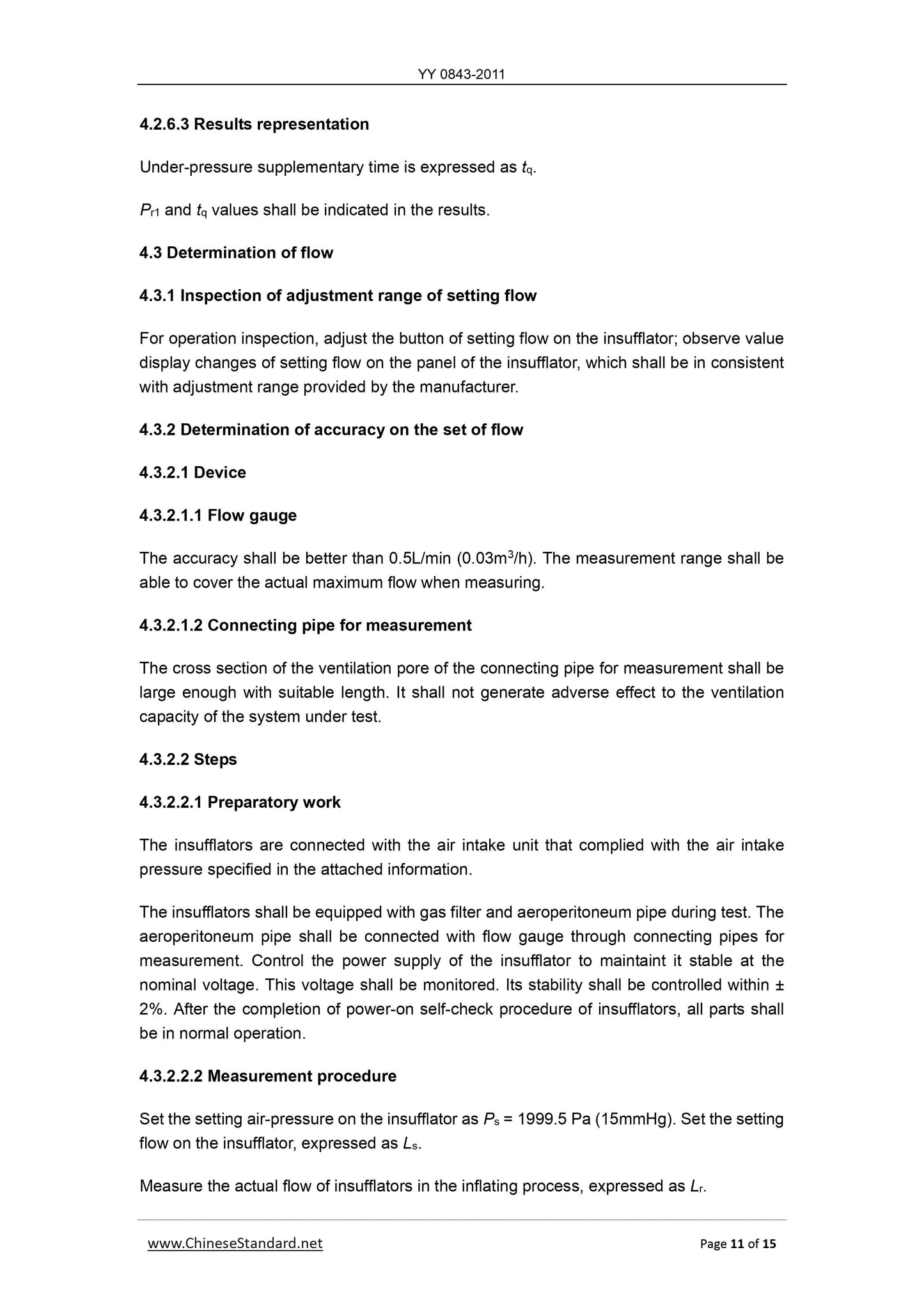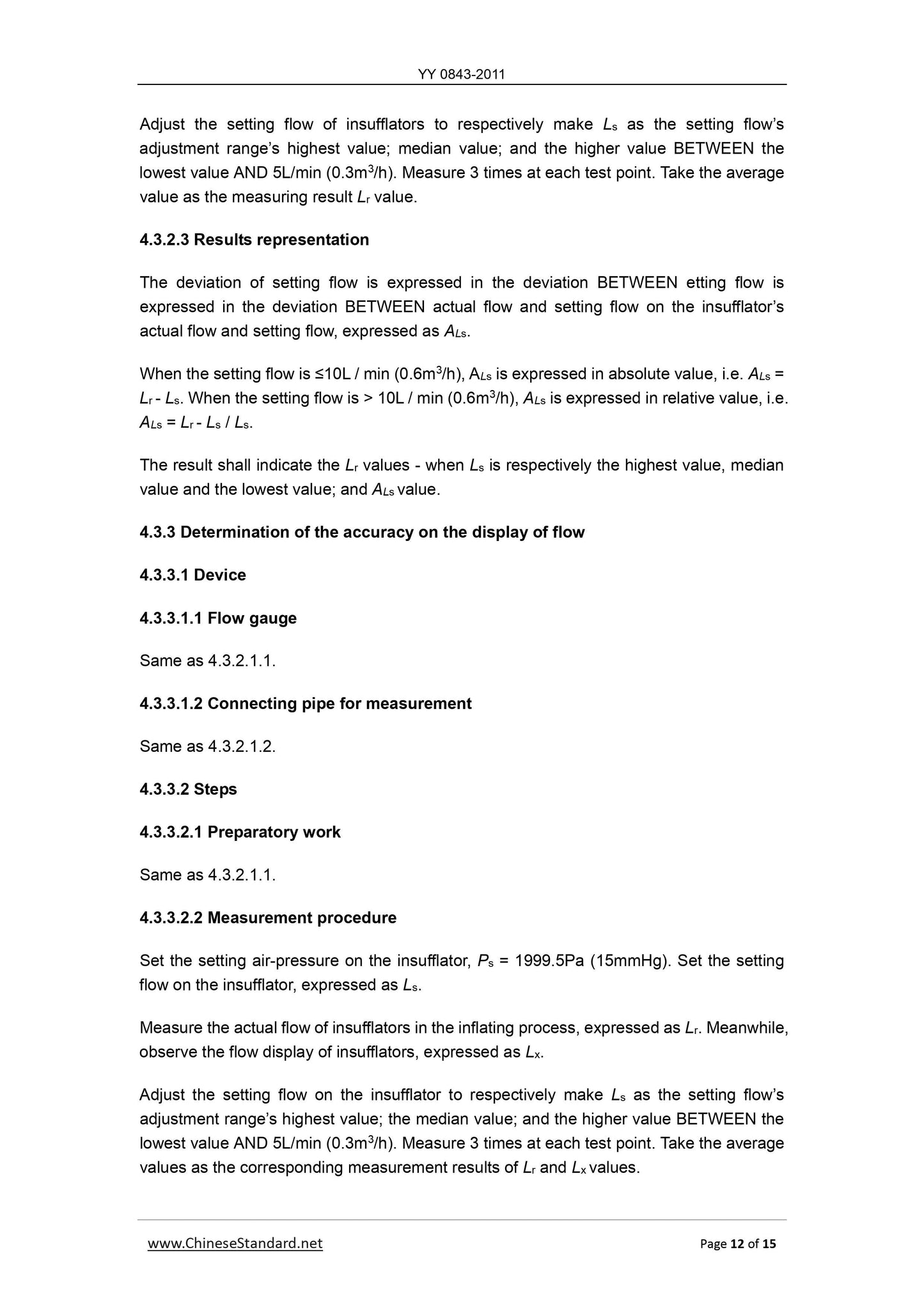1
/
の
12
PayPal, credit cards. Download editable-PDF & invoice in 1 second!
YY 0843-2011 English PDF (YY0843-2011)
YY 0843-2011 English PDF (YY0843-2011)
通常価格
$150.00 USD
通常価格
セール価格
$150.00 USD
単価
/
あたり
配送料はチェックアウト時に計算されます。
受取状況を読み込めませんでした
Delivery: 3 seconds. Download true-PDF + Invoice.
Get QUOTATION in 1-minute: Click YY 0843-2011
Historical versions: YY 0843-2011
Preview True-PDF (Reload/Scroll if blank)
YY 0843-2011: Medical endoscopes - Endoscope supply units - Insufflators
YY 0843-2011
Translated English of Chinese Standard. YY0843‐2011
YY
ICS 11.040.99
C 40
INDUSTRY STANDARD
OF THE PEOPLE’S REPUBLIC OF CHINA
Medical endoscopes - Endoscope supply units -
Insufflators
ISSUED ON. DECEMBER 31, 2011
IMPLEMENTED ON. JUNE 1, 2013
Issued by. State Food and Drug Administration
Table of Contents
Foreword ... 3
1 Scope ... 4
2 Normative references ... 4
3 Requirements ... 4
4 Test methods ... 6
5 Inspection rules ... 15
Foreword
This Standard is drafted according to the rules specified in GB/T 1.1-2009
Please note that some contents in this document may involve in patents. The issuing
authority of this document will not be responsible to identify these patents.
This Standard was proposed by State Food and Drug Administration.
This Standard shall be under the jurisdiction of National Technical Sub-committee
(SAC/TC 103/ SC 1) on Medical Optical and Instrument of Standardization Administration
of China.
Drafting organizations of this Standard. Hangzhou Medical Equipment Quality Supervision
and Inspection Center of State Food and Drug Administration, and Zhejiang Medical
Equipment Inspection Center.
The main drafting staffs of this standard. Yan Qinglai, Jia Xiaohang, He Tao, Zhang
Qinyuan, and Mao Xinxin.
Medical endoscopes - Endoscope supply units -
Insufflators
1 Scope
This Standard specifies the requirements and test methods of carbon dioxide insufflators
for medical endoscope.
This Standard applies to the carbon dioxide insufflators that is used in the endoscopic
surgery. The product is used to establish and maintain the pneumoperitoneum in
minimally invasive endoscopic surgery.
2 Normative references
The articles contained in the following documents have become part of this document
when they are quoted herein. For the dated documents so quoted, all the modifications
(including all corrections) or revisions made thereafter shall be applicable to this
document.
GB 9706.1-2007 Medical electrical equipment - Part 1. General requirements for
safety
GB 9706.19-2000 Medical electrical equipment - Part 2. Particular requirements for the
safety of endoscopic equipment
3 Requirements
3.1 Interface specifications
The suction interface type and connection thread between the insufflator and external air
source shall comply with requirements in GB 15383-1994.
3.2 Air-pressure
3.2.1 Adjustment range of setting air-pressure
The manufacturer shall provide the adjustment range of setting air-pressure. The
adjustment range shall include 1999.5Pa (15mmHg); and it is consistent with the actual
adjustment range of setting air-pressure of insufflators.
3.2.2 Accuracy of the air-pressure presetting
big enough. It shall not generate adverse effect to the ventilation capacity of the system
under test.
4.2.2.1.2 Air-pressure gauge
Its accuracy shall be better than 79.9 Pa (0.6 mmHg). The measurement range shall be
able to cover the actual maximum pressure range when measuring.
4.2.2.1.3 Connecting pipe for measurement
The cross section of ventilation pore that connects to the pipe for measurement shall be
big enough with suitable length. It shall not generate adverse effect to the ventilation
capacity of the system under test.
4.2.2.2 Steps
4.2.2.2.1 Preparatory work
The insufflators are connected with the air intake unit that comply with the air intake
pressure specified in the attached information.
The insufflators shall be equipped with gas filter and aeroperitoneum pipe during test. The
aeroperitoneum pipe shall be connected with deflated simulation abdominal cavity
through the connection pipes for measurement.
Simulative abdominal cavity shall be connected with the air-pressure gauge through
connecting pipe for measurement.
Control the power supply of the insufflator to maintain it stable at the nominal voltage. This
voltage shall be monitored. The voltage stability shall be controlled within ± 2%.
After the completion of the starting self-check procedure of the irrigation pump, each
component shall work normally.
4.2.2.2.2 Measurement procedure
Set the setting air-pressure on the insufflator, expressed as ps. If the setting flow on the
insufflator is adjustable, set its setting flow to the maximum value.
After establishing aeroperitoneum at the simulative abdominal cavity, adjust its gas switch
to a tiny leakage state. In the process of keeping aeroperitoneum, measure the actual
air-pressure pr within the simulative abdominal cavity. The numerical value of pr may be
fluctuant. Record the Pr value when |Pr—Ps| is at miximum.
Adjust the setting air-pressure on the insufflator, so as to make ps take at least 5 values.
And it shall at least include the setting air-pressure’s adjustment range’s highest value;
1999.5 Pa (15mmHg); the lowest value [if the lowest value ≤666.5 Pa (5mmHg), then the
lowest value of ps shall be 666.5 Pa (5mmHg)]. Measure 3 times at each test point. Take
The result shall indicate the Ps, Pr, Px and Apx values, when Ps is the 5 values set in
4.2.3.2.2 respectively.
4.2.4 Determination of overpressure alarm function
4.2.4.1 Device
Same as 4.2.2.1.
4.2.4.2 Steps
4.2.4.2.1 Preparatory work
Same as 4.2.2.2.1.
4.2.4.2.2 Measurement procedure
Set the setting air-pressure on the insufflators as Psg = 1999.5 Pa (15mmHg). If the setting
flow on the insufflator is adjustable, set its setting flow to the maximum value.
After establishing aeroperitoneum at simulative abdominal cavity, through the auxiliary
methods, gradually increase the air-pressure within the simulative abdominal cavity until
insufflator alarms due to overpressure. Meanwhile, measure the actual air-pressure within
the simulative abdominal cavity, expressed as Prg.
4.2.4.3 Results representation
The alarm air-pressure difference of overpressure alarm is expressed as Prg-Psg.
4.2.5 Determination of overpressure release function
4.2.5.1 Device
4.2.5.1.1 Simulative abdominal cavity
Same as 4.2.2.1.1.
4.2.5.1.2 Air-pressure gauge
Same as 4.2.2.1.2.
4.2.5.1.3 Connecting pipe for measurement
Same as 4.2.2.1.3.
4.2.5.1.4 Timing device
Accuracy shall be better than 0.01s.
4.2.6.3 Results representation
Under-pressure supplementary time is expressed as tq.
Pr1 and tq values shall be indicated in the results.
4.3 Determination of flow
4.3.1 Inspection of adjustment range of setting flow
For operation inspection, adjust the button of setting flow on the insufflator; observe value
display changes of setting flow on the panel of the insufflator, which shall be in consistent
with adjustment range provided by the manufacturer.
4.3.2 Determination of accuracy on the set of flow
4.3.2.1 Device
4.3.2.1.1 Flow gauge
The accuracy shall be better than 0.5L/min (0.03m3/h). The measurement range shall be
able to cover the actual maximum flow when measuring.
4.3.2.1.2 Connecting pipe for measurement
The cross section of the ventilation pore of the connecting pipe for measurement shall be
large enough with suitable length. It shall not generate adverse effect to the ventilation
capacity of the system under test.
4.3.2.2 Steps
4.3.2.2.1 Preparatory work
The insufflators are connected with the air intake unit that complied with the air intake
pressure specified in the attached information.
The insufflators shall be equipped with gas filter and aeroperitoneum pipe during test. The
aero...
Get QUOTATION in 1-minute: Click YY 0843-2011
Historical versions: YY 0843-2011
Preview True-PDF (Reload/Scroll if blank)
YY 0843-2011: Medical endoscopes - Endoscope supply units - Insufflators
YY 0843-2011
Translated English of Chinese Standard. YY0843‐2011
YY
ICS 11.040.99
C 40
INDUSTRY STANDARD
OF THE PEOPLE’S REPUBLIC OF CHINA
Medical endoscopes - Endoscope supply units -
Insufflators
ISSUED ON. DECEMBER 31, 2011
IMPLEMENTED ON. JUNE 1, 2013
Issued by. State Food and Drug Administration
Table of Contents
Foreword ... 3
1 Scope ... 4
2 Normative references ... 4
3 Requirements ... 4
4 Test methods ... 6
5 Inspection rules ... 15
Foreword
This Standard is drafted according to the rules specified in GB/T 1.1-2009
Please note that some contents in this document may involve in patents. The issuing
authority of this document will not be responsible to identify these patents.
This Standard was proposed by State Food and Drug Administration.
This Standard shall be under the jurisdiction of National Technical Sub-committee
(SAC/TC 103/ SC 1) on Medical Optical and Instrument of Standardization Administration
of China.
Drafting organizations of this Standard. Hangzhou Medical Equipment Quality Supervision
and Inspection Center of State Food and Drug Administration, and Zhejiang Medical
Equipment Inspection Center.
The main drafting staffs of this standard. Yan Qinglai, Jia Xiaohang, He Tao, Zhang
Qinyuan, and Mao Xinxin.
Medical endoscopes - Endoscope supply units -
Insufflators
1 Scope
This Standard specifies the requirements and test methods of carbon dioxide insufflators
for medical endoscope.
This Standard applies to the carbon dioxide insufflators that is used in the endoscopic
surgery. The product is used to establish and maintain the pneumoperitoneum in
minimally invasive endoscopic surgery.
2 Normative references
The articles contained in the following documents have become part of this document
when they are quoted herein. For the dated documents so quoted, all the modifications
(including all corrections) or revisions made thereafter shall be applicable to this
document.
GB 9706.1-2007 Medical electrical equipment - Part 1. General requirements for
safety
GB 9706.19-2000 Medical electrical equipment - Part 2. Particular requirements for the
safety of endoscopic equipment
3 Requirements
3.1 Interface specifications
The suction interface type and connection thread between the insufflator and external air
source shall comply with requirements in GB 15383-1994.
3.2 Air-pressure
3.2.1 Adjustment range of setting air-pressure
The manufacturer shall provide the adjustment range of setting air-pressure. The
adjustment range shall include 1999.5Pa (15mmHg); and it is consistent with the actual
adjustment range of setting air-pressure of insufflators.
3.2.2 Accuracy of the air-pressure presetting
big enough. It shall not generate adverse effect to the ventilation capacity of the system
under test.
4.2.2.1.2 Air-pressure gauge
Its accuracy shall be better than 79.9 Pa (0.6 mmHg). The measurement range shall be
able to cover the actual maximum pressure range when measuring.
4.2.2.1.3 Connecting pipe for measurement
The cross section of ventilation pore that connects to the pipe for measurement shall be
big enough with suitable length. It shall not generate adverse effect to the ventilation
capacity of the system under test.
4.2.2.2 Steps
4.2.2.2.1 Preparatory work
The insufflators are connected with the air intake unit that comply with the air intake
pressure specified in the attached information.
The insufflators shall be equipped with gas filter and aeroperitoneum pipe during test. The
aeroperitoneum pipe shall be connected with deflated simulation abdominal cavity
through the connection pipes for measurement.
Simulative abdominal cavity shall be connected with the air-pressure gauge through
connecting pipe for measurement.
Control the power supply of the insufflator to maintain it stable at the nominal voltage. This
voltage shall be monitored. The voltage stability shall be controlled within ± 2%.
After the completion of the starting self-check procedure of the irrigation pump, each
component shall work normally.
4.2.2.2.2 Measurement procedure
Set the setting air-pressure on the insufflator, expressed as ps. If the setting flow on the
insufflator is adjustable, set its setting flow to the maximum value.
After establishing aeroperitoneum at the simulative abdominal cavity, adjust its gas switch
to a tiny leakage state. In the process of keeping aeroperitoneum, measure the actual
air-pressure pr within the simulative abdominal cavity. The numerical value of pr may be
fluctuant. Record the Pr value when |Pr—Ps| is at miximum.
Adjust the setting air-pressure on the insufflator, so as to make ps take at least 5 values.
And it shall at least include the setting air-pressure’s adjustment range’s highest value;
1999.5 Pa (15mmHg); the lowest value [if the lowest value ≤666.5 Pa (5mmHg), then the
lowest value of ps shall be 666.5 Pa (5mmHg)]. Measure 3 times at each test point. Take
The result shall indicate the Ps, Pr, Px and Apx values, when Ps is the 5 values set in
4.2.3.2.2 respectively.
4.2.4 Determination of overpressure alarm function
4.2.4.1 Device
Same as 4.2.2.1.
4.2.4.2 Steps
4.2.4.2.1 Preparatory work
Same as 4.2.2.2.1.
4.2.4.2.2 Measurement procedure
Set the setting air-pressure on the insufflators as Psg = 1999.5 Pa (15mmHg). If the setting
flow on the insufflator is adjustable, set its setting flow to the maximum value.
After establishing aeroperitoneum at simulative abdominal cavity, through the auxiliary
methods, gradually increase the air-pressure within the simulative abdominal cavity until
insufflator alarms due to overpressure. Meanwhile, measure the actual air-pressure within
the simulative abdominal cavity, expressed as Prg.
4.2.4.3 Results representation
The alarm air-pressure difference of overpressure alarm is expressed as Prg-Psg.
4.2.5 Determination of overpressure release function
4.2.5.1 Device
4.2.5.1.1 Simulative abdominal cavity
Same as 4.2.2.1.1.
4.2.5.1.2 Air-pressure gauge
Same as 4.2.2.1.2.
4.2.5.1.3 Connecting pipe for measurement
Same as 4.2.2.1.3.
4.2.5.1.4 Timing device
Accuracy shall be better than 0.01s.
4.2.6.3 Results representation
Under-pressure supplementary time is expressed as tq.
Pr1 and tq values shall be indicated in the results.
4.3 Determination of flow
4.3.1 Inspection of adjustment range of setting flow
For operation inspection, adjust the button of setting flow on the insufflator; observe value
display changes of setting flow on the panel of the insufflator, which shall be in consistent
with adjustment range provided by the manufacturer.
4.3.2 Determination of accuracy on the set of flow
4.3.2.1 Device
4.3.2.1.1 Flow gauge
The accuracy shall be better than 0.5L/min (0.03m3/h). The measurement range shall be
able to cover the actual maximum flow when measuring.
4.3.2.1.2 Connecting pipe for measurement
The cross section of the ventilation pore of the connecting pipe for measurement shall be
large enough with suitable length. It shall not generate adverse effect to the ventilation
capacity of the system under test.
4.3.2.2 Steps
4.3.2.2.1 Preparatory work
The insufflators are connected with the air intake unit that complied with the air intake
pressure specified in the attached information.
The insufflators shall be equipped with gas filter and aeroperitoneum pipe during test. The
aero...
Share
